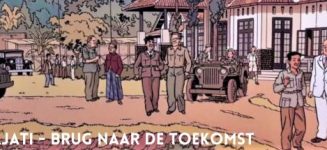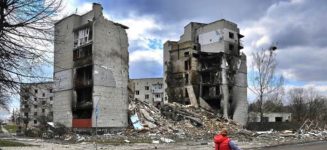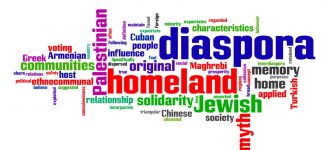Nov. 10 is Heroes’ Day and will remain so. For some, however, the days surrounding that date in 1945 are a nightmare. What made them such a horror was the Bersiap – the violent attacks of Indonesian independent guerilla fighters killing hundreds of allegedly pro-Dutch Indo-Europeans, Chinese, Ambonese and Manadonese.

Bersiap was the word used by the Japanese-trained militia, the PETA, to order its members to be “ready” for action. During the event, it presumably became a code word for the pemoeda, the youth, to call their fellow countrymen to fight the “colonialists”. Decades later, for many in the Netherlands that simple word has become a vivid reminder of the brutality of that time.
The atrocities in Surabaya began late October as the young militia acquired Japanese weapons amid the confusion when Dutch officers joined the Allied forces assigned to take over control from the defeated Japanese. In the Simpang and Gubeng areas of Surabaya, also in Central Java’s Ambarawa and in Jakarta, many innocent civilians, including women and children, were killed and thousands went missing.
The events acquired renewed significance very recently, as the Netherlands’ ruling liberal-conservative political party VVD demanded that the violence should be revealed in a big academic research project on the war of decolonization (See “Will we see decolonizing of Dutch decolonization war?” by this writer, The Jakarta Post, Sept. 27, 2017).
While some academics argue that the Bersiap could possibly be viewed as genocide, others argue that it has too often been viewed as isolated events. Nevertheless, violence breeds violence. The Dutch colonial history and Indonesia’s independence war are good cases to view violence from a long-term perspective.
Although it began as robbery along the Maluku islands and the northern coast of Java, the Dutch East India Company (VOC) has taught us the impacts of power games and violence for local societies through two-and-a-half centuries. Centuries of war, alliances and domination have strengthened the perceptions of political games and dominance between and among the VOC and the past kingdoms of today’s Indonesia.
Historian MC Ricklef’s study of 18th-century Mataram reminds us of the intricacies of Javanese rulers’ relationship with the VOC and its successors. In a cultural sense, the two are often far from being in separate categories, as they came to develop parallel perspectives over the centuries of what state dominance should be.
Rule, domination and regional hegemony could only be built over time once stability was achieved and properly and carefully maintained. And stability is precisely the prerequisite of what historian Soemarsaid Moertono saw as the most legitimate and pivotal role of the Javanese ideal of the relationship between the ruler and the ruled (kawula-gusti).
Indeed it was their later successors, the Netherlands-Hindia state and Indonesia’s New Order, that learned much about the same power idioms. To oppose the state is to become the enemy that must eventually be annihilated. In reproducing their respective patterns of state dominance, these rulers were merely good students of the VOC and the Javanese rulers of the past.
They created, in effect, what anthropologist J. Pemberton describes in his On the Subject of Java as “the legitimate posturing of power”, such that it would appear to be taken for granted.
Thus, the prevailing slogans of Dutch colonial rule, Rust en Orde (tranquility and order) and that of the New Order, kamtibnas (keamanan & ketertiban nasional, or national order and security) became the common essence of their doctrines to divide and rule. And violence is definitely no stranger to such doctrines.
When the Dutch, joining the British, returned to Java in 1945 – claiming to have come to restore the sacred “tranquility and order” – they provoked the local people to respond violently, in exactly the way they used to respond. But, in a time of revolt and revolution, the contradictions couldn’t be harsher.

Local movements, of which the Bersiap events were a part, responded to the Dutch aggression. They were not exactly organized, but the brutalities were of a similar magnitude as the violence that occurred in the series of local movements concurrent with the Bersiap period – 1945-1946.
In terms of spirit, they were profoundly similar to the events known as the Peristiwa Tiga Daerah, the affair of three regencies, in which left-wing units revolted along Java’s northern coast; the social revolution in Surakarta, Central Java, against the local aristocrats who were the new administrators of the crumbling colonial rule; and the Cumbok War against the Acehnese aristocrats, or the uleebalang ruling class.
These were peoples’ movements against the colonial domination built by the Dutch and the local aristocracy.
As with elsewhere at the time, as former Sukarno aide Roeslan Abdulgani has reminded us, the Bersiap, too, was preceded by weeks of British bombing during the holy month of Ramadhan in 1945.
Alas, today, some Dutch perspectives, precisely because they were victims and the losers, tend to view the Bersiap as a special case and quite separate from the local uprisings against colonial domination and aggression. In Indonesia, the Bersiap is less known as an episode of violence, because it was seen as patriotism and heroism on the part of the victors.
Therefore in response to the views, mainly in the Netherlands, that the incidents of Bersiap were “the mother of all violence”, I will leave behind the words as my friend, the late PP van Lelyveld, who as a child suffered in the Japanese camps and in the Bersiap violence, reminded me: “Well, that was a time of revolution.”




In my opinion we need to introduce a lot of distinctions into this debate, otherwise it will serve apologetics (of colonialism in the first place, like in the Netherlands, but to some extent also in the Indonesian nationalist right) to discredit anti-colonialist militancy in general. I’m currently travelling without access to my archives, so forgive me if on some issues
Thankyou Thomas Rieger. Correct. Am aware of the risk that it may sound apologetic. The trouble with this topic is there are still too few, if any, good and accurate research in comparative perspective. My note is just to point at the lack of this comparison.
so these are the distinctions that I feel could be helpful (but that I’m sure you will complete with some others that I’ve not yet thought of):
– one is between the violence committed by the fascist occupiers (Japanese army, secret services etc.) against civilian citizens of the former colonizers and acts of violence committed in the decolonization struggle (without any intention to excuse the latter, but it would be absurd to put both on par);
– another one is – I’m pretty sure this statement will invite some rejection – is between the violence committed by the Dutch and British troops trying to reimpose colonial rule against Indonesian civilians (and combattants) and the violence of the fairly uncoordinated youth movements that sprang up all over Indonesia; I’m arguing that in a somehow Fanonian spirit we should be careful not to put the largely spontaneous (some on the spot planning not withstanding) violence by the oppressed getting in motion (after suffering abject humiliation at the hands of the Dutch colonizers and the fascist Japanese occupation forces) on the same level (once again without any intention to excuse clear violations of human rights) as the murderous violence unleashed by the reconquering Dutch forces; this is important, because the ultimate aim of some groups of the political and scientific establishment in focussing on the excesses of the bersiap period is to balance the recent revelations about Dutch war crimes in their colonial war; it is further important to note, that it was the Dutch colonial administration that rejected repeated calls of the nationalist movement prior to the Japanese assault to organizes the defence of the territory and the hasty capitulation of the Dutch forces delivering the whole population to the Tenno’s savagery that brought about some of the bitterness resulting in the excesses in question;
– one more distinction that could be useful is that between suspicion of infiltration and could blooded ethnic cleansing: some of those committing the excesses were driven by fear of Europeans/”Indos”/local KNIL-personnel identifiable as such on ethnic grounds (Moluccan/Menadonese) linking up with the invading allied troops, but some were hard boilt racists oposing the very idea of diversity in Indonesian society, like the “hero” of the battle of Surabaya, Sutomo/”Bung Tomo” who published a disgustingly racist manifesto against the Chinese minority in the late 50s/early sixties (it’s this staff that I nee to check when back to my archives).
– finally a distinction has to be drawn between violence against civilians in the framework of social upheaval (like the killing of a considerable part of the Malay nobility in East Sumatra and Aceh in 1946, Anthony Reid’s “Blood of the People” would still be the reference for this) and the numerous racist attacks on the Chinese minority under the disguise of social emancipation (Siauw Giok Tjan’s “Lima Zaman” provides some valubale accounts of this) – to make the logic somehow more easily understandable for European progressives, although comparisons are never very neat: one would not put on the same level the killing of the Tsar family by the Tcheka/Bolsheviks and the murderous pogrom’s against Jews in Ukraine by nationalist forces, although both had to do with the evolution kicked of by the October Revolution.
That’s it for today, I will gladly come back to the discussion once back home. I will then put a scan of Sutomo’s trash at your disposal. Sorry for the not terribly organized presentation of my thoughts. And don’t hesitate to give some critical feedback…
I am neither Indonesian nor Dutch, but allow me share my humble view from outside. As Japanese I thought about the history of Indonesia/Dutch East Indies for years, as some of you know already.
This article covers both Indonesian and Dutch perspectives. In this sense it is better than one-sided view. But two sides are just even, nothing more and not promising for the future yet.
A Japanese professor at Harvard, Akira Iriye, said: “A history that you cannot share with others cannot be called history.” This “ istory” in a strict sense about the Bersiap, which Indonesians and Dutch can share, is still to be discovered, discussed, or invented.
How can this “history” be achieved? According to a quote by A. Einstein “You can never solve a problem on the level on which it was created,” one possibility might be that both sides climb up to a higher level than the level of the natinal interest of Indonesia or Holland. Maybe we can replace them with common values like peace or humanity, which are common to the both side.
In other words, if both sides can admit that it does make sense to stay in the impasse of conflicting views, they can start asking themselves what could be an alternative or a win-win situation for the both sides about their history?
A major cause of colony/discrimination/racism is a desire to control others in my opinion. A sad consequence is that, when the victims search justice about the dark past, they ask for apology and compensation. It looks as if they want to take over the control or a revenge, so that the victims can control the others instead of being controled as before. It’s understandable, but it means that the battle for the control goes on to the future. The idea of climbing up to a new level is also useful to get out of this endless battle.
Thank you for your attention.
Thankyou Fumi Hoshino. I think you’re right, the two perspectives, of the victims and the victorious, may be hard to reconcile – at least at the level of general public. As with many great injustice, the struggle may be of a long term one, but not necesarrily endless.
The above picture relates to the Battle of Surabaya. In this case, the people, who considered the freedom fighters as the villains; are of course among others were the relatives of the British Brigadier General Mallaby and the colonial Dutch henchmen. The British army at that time had the intention to restore the Dutch colonial government in Indonesia, which exploited them as indigenous in corvée labors and did not treat them better than dogs. (Note: In some of the colonial public facilities walls during the colonial period were written: “Verboden voor honden en inlanders” / Prohibited for dogs and indigenous).